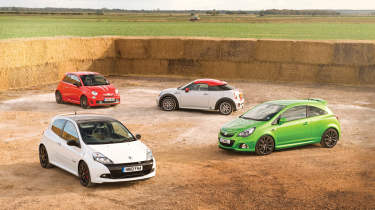Mini Coupe JCW v Renault Clio 200 v Corsa VXR Nurburgring v Abarth 695 Tributo
Mini's pumped-up John Cooper Works Coupe tackles its hot hatch foes, the Clio 200 Cup, Corsa VXR Nurburgring and Abarth 695 Tributo Ferrari
As perfect driving combinations go, a glorious autumn day, a deserted B-road and a quartet of sparky little hot hatches really takes some beating, especially when the hatches in question are the freshest and hottest of the breed.
Not so many years ago, a hatchback with more than 200bhp would have been regarded with awe, yet nowadays a couple of hundred ponies really is the entry level for the serious drivers’ supermini. It’s a fiercely contested niche and one that provides a really diverse and intriguing collection of cars, four of which we’ve gathered for this test.
Renaultsport has come to define all that’s great about hot hatches, and the Clio 200 Cup is a real evo favourite. A no-frills spec, no-nonsense dynamics and sensible pricing (£16,930) make it hard to resist. Its naturally aspirated 197bhp 2-litre engine is a real firecracker, but its love of revs and lack of torque does leave it exposed to the threat of some new turbocharged rivals.
Mini and Vauxhall are also hot hatch stalwarts, so the introduction of the quirky Mini Coupe (£23,795 in John Cooper Works spec, as here) and hardcore Corsa VXR Nürburgring (£22,295) have to be taken seriously. With a tad more power (208 and 202bhp respectively) and a whole heap more torque, they have the muscle to put the Clio under serious pressure.
More reviews
Group tests
Reviews
- Mini JCW 2025 review – too feisty for its own good
- Mini JCW Electric 2025 review – the Alpine A290 has nothing to worry about
- Mini John Cooper Works review
- Mini John Cooper Works Convertible review
- Mini John Cooper Works GP (R56, 2013 - 2014) review
- Mini John Cooper Works GP review
- Mini JCW WC50 review
- Mini Clubman JCW
As no evo group test would be complete without a wildcard entry, we’ve also thrown an Abarth 695 Tributo Ferrari into the mix. At the best part of £30,000 it’s a crazy car, but with 178bhp from just 1.4 turbocharged litres, plus a single-clutch paddle-shift transmission and enough carbonfibre to make a Pagani owner smile, the hotted-up pocket-sized Fiat is a welcome splash of irreverent colour.
All four cars fight for your attention, but it’s the Mini that arouses the greatest curiosity, so that’s the key I grab first. The rakish windscreen, bubble roof and abrupt bobtail are undeniably bold, but there’s something slightly odd about the overall effect. Personally I can’t forget (however hard I try) the Coupe’s designer saying the roof was supposed to represent a baseball cap worn backwards. It all seems desperately uncool, the four-wheeled equivalent of your dad dancing.
Like the exterior, the interior is an acquired taste. To my eyes it tries far too hard, but it does feel a cut above the Abarth and Renault for quality. The speedo-cum-satnav screen is ridiculously huge, yet ironically it is actually quite hard to read the speedo. The two-seat cockpit feels rather confined, but the clever domes in the headlining win plenty of headroom for taller drivers. Rear visibility is rotten, though.
The driving position is nice and low so you feel part of the car, but the steering wheel rim has caught elephantitis from BMW’s M Division and feels too fat in your hands. The turbocharged 1.6-litre engine is strong from the outset, pulling hard and smooth to the 6500rpm red line. With 206lb ft from just 1850rpm, the JCW Coupe delivers big-car torque, which gives you stonking overtaking ability and high-gear roll-on acceleration, but in the lower gears it asks too much of the chassis, which wriggles and writhes and squirms with torque-steer.
Point to point, this Mini is a truly quick car with strong brakes and a tight, punchy gearshift, but it takes some hanging on to. The wheel control is crashy and there’s a slight disconnect between the response of the front and rear ends, which tends to exacerbate the wayward behaviour under hard acceleration. When you turn the ESP off, the Coupe struggles for traction (it uses electronics to attempt to mimic the action of a limited-slip differential) and can also exhibit surprising amounts of turn-in and lift-off oversteer. As a result it feels hyperactive at best, ragged at worst, and on a bumpy, wiggly B-road it all conspires to make the car feel borderline unstable. Is the JCW engine and suspension a step too far? On this evidence, yes.
From the Marmite styling of the Mini to the Hollywood looks of the Corsa VXR. Even in Kermit Puree Green it still looks fantastic, with chiselled features and a road-skimming stance. The Nürburgring upgrades are comprehensive and joined up. Bespoke Bilstein springs and dampers, a 20mm front and 15mm rear reduction in ride height, better Brembo brakes, lighter alloy wheels and a multi-plate mechanical limited-slip differential have been fitted to get the best from the revised 1.6-litre engine, which has turbo, exhaust and management modifications to boost power and torque outputs to 202bhp and 206lb ft respectively.
The leather upholstery and Nürburgring decals enhance the Corsa with varying levels of success. Some elements are great, some are rather tacky, which aptly is a bit like the Nürburgring itself. Judged as a whole, though, there’s no doubt it’s a proper petrolhead’s upgrade and one that justifies the chunky £3395 premium over the regular VXR.
After the hyperactive Mini, the Corsa at first feels rather inert. The steering is lighter and there’s less fight through the wheel, while the suspension, although firm, has greater control and consistency. The gearshift, or to be more specific the large, oddly shaped knob itself, is quite awkward, but you learn to work with it.
There’s a phase where you feel slightly underwhelmed by the VXR, but gradually it reveals more character and ability, so you warm to it and dig a bit deeper. Despite posting an identical peak torque figure, the VXR Nürburgring doesn’t feel quite as fiercely accelerative as the JCW Mini, but this is most likely down to delivery rather than a genuine performance gap. The Vauxhall doesn’t sound as fruity as the Mini either, which is perhaps more disappointing.
No matter, for driven hard along the same roads, the Corsa exhibits a far greater level of composure and much better traction. You can really sense the limited-slip diff working, so once you’ve got the nose turned in and get back on the power you can feel the inside front wheel pulling the nose round and tightening your line. It requires an adjustment to your driving style, but once the penny drops you have great faith in the Corsa’s cornering ability.
If there’s one thing you wish the VXR had it’s a bit of throttle adjustability. Vauxhall (or rather Opel, and its OPC performance division) traditionally sets up its hot hatches to be supremely stable, and the Corsa Nürburgring is true to type, with a resolutely nose-led stance. It’s nicely grippy and 100 per cent trustworthy, but when you really push it (with ESP off) it leans too hard on the outside front wheel and refuses to be coaxed, cajoled or provoked with a lift of the throttle on turn-in. This is frustrating, not least because you sense it’s a cultural thing rather than a lack of understanding from the OPC engineers.
If they want a lesson in livewire dynamics they need look no further than the Clio 200 Cup. We’ve written so many eulogies about this car, but it deserves every column inch of praise, for no hot hatch makes the most of what it has more effectively and, crucially, more entertainingly than this Renaultsport Clio.
That’s not to say it’s perfect, for having jumped into it after the Corsa your immediate thought is, where’s the power gone? The answer is about 1500rpm further round the tacho. Yes, the Clio needs revs like you and I need oxygen. The more the better, in fact, for you need 7100 of them to find all 197bhp (200PS), and 5400 of them to extract the naturally aspirated 2-litre engine’s relatively modest torque peak of 159lb ft.
Consequently you need to forget the high-gear roll-on driving style that’s perfectly adequate to go very, very fast in the Mini or Corsa and instead adopt a Hertz rental drive-it-like-you-stole-it approach, at which point the Clio comes alive. As evo’s resident sage Harry Metcalfe points out, this relies on you having the opportunity to do so, which means a clear road, but when the gods conspire to deliver empty tarmac, the Renault is in a different league.
Everything is so communicative, from the great brakes and whip-crack gearchange to the perfectly telegraphed grip from each corner of the car, that you instantly feel as though you’ve been driving the 200 Cup all your life. Seriously, it’s your best friend on four wheels: predictable, exploitable, encouraging, enthusiastic, dependable and always forgiving. In fact I’d go so far as to say no other front-drive car on sale has its poise and minutely adjustable balance.
It’s a pretty basic package in terms of creature comforts, but as the cheapest car here by over £5K you can afford some options. The cloth Recaros are perfectly functional and set the appropriate tone, just as cloth Recaros do in a 997 GT3 RS, but still the materials and general ambience fall short of the Mini and Corsa. If you value soft-touch plastics this might deter you from the Clio, but it’s a small price to pay for such dynamic brilliance.
You can’t help but smile at the Abarth 695. It’s an absurd amount of money – nearly £6K more than the Mini and a whopping £12,670 more than the Clio – but there’s something rather special about the leather, funky wheels, quad exhaust pipes, enamel badges and carbonfibre. It really does do a pretty convincing job of being a baby Ferrari, especially when you spot the paddle-shift transmission and drilled brake discs front and rear.
Some of the cosmetic package is less than convincing, though. The plastics feel and look very cheap indeed, as do the switches for the ventilation system. I suppose you can’t completely disguise the 695’s origins, but a bit of Alcantara would have gone a long way to cover the worst bits of trim.
Twist the key and the Tributo does all it can to win you over again. Those four exhaust pipes emit a proper turbocharged gurgle, which suggests big boost and plenty of fun. You sit quite high and over the steering wheel, but with only two pedals the driving position is less of an issue than in the manual 500 Esseesse. You engage drive by pressing a button with ‘1’ on it. There’s then a choice of auto or manual modes. Sounds a bit of a faff, but the switches are intuitive so you soon become used to it. Low-speed manoeuvring, however, can be a little jerky.
The most important button is the one marked ‘Sport’, for it brings the throttle response and transmission to life. There’s plenty of urgency to the 695’s performance and impressive low- and mid-range muscle that really shoves you through the gears. With just five forward ratios the gearing is tall, but the 1.4-litre turbocharged engine has the torque to make them work. Consequently the 695 is a deceptively rapid little car. Give it free rein and it seems to settle at a natural 90mph, which is great fun, but a rather weak defence should you attract the attention of Her Majesty’s Constabulary.
If the pace and delivery are impressive and engaging in equal measure, the suspension and steering are rather less satisfying. The damping is slightly more rounded than the Esseesse’s, but if you’ve ever driven one you’ll know that’s not saying much. There’s a constant fidgety feeling from all four corners, and if you hit a sequence of bumps the Abarth can buck and pitch uncomfortably. At speed it’s enough to deflect you from your chosen course, but if you temper your pace slightly it can be at least partially tamed.
What remains constantly frustrating is the steering, which is almost totally numb. It’s a huge shame because the 695 is a car you really want to chuck around, but the dead steering means you never feel the tyres begin to absorb the lateral load or key into the road. There’s also a strange stickiness to the self-centring, and a resistance rather than weight felt through the rim. With better feedback from the steering you could at least partially forgive the rotten damping, but together they’re a deal-breaker if you take your driving seriously. The Verdict
After much consideration it feels right to put the Mini and Abarth in equal third place. The former is a very strange car in both concept and looks, to the point where it’s hard to see why you’d want to sacrifice two rear seats for no gain in performance and a dubious stab at individuality. The fact it’s also a pretty ragged thing to drive hard is extremely disappointing and at odds with how any fast Mini should feel.
The latter’s near-£30K price tag renders it largely irrelevant, which is perhaps just as well given its dynamic limitations. The numb steering and pogo-stick suspension are major flaws that inhibit your pace on country roads. So it says an awful lot for the car’s overall charm that it’s still a very easy car to love. If you had the money to burn you probably would.
An honourable second – by some margin – goes to the Corsa. With handsome styling, impressive build quality and gutsy performance, it’s a very desirable package. Its sense of connection and agility isn’t in the Clio’s league, but it has genuine ability and strong ownership appeal.
So it’s a win for the Clio Cup. There’s no denying it needs effort to make it sing, but as a car to fire down a great stretch of A- or B-road it’s about as good as front-wheel drive gets.



